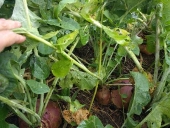

My PEP Badge Tracker: An easier way to track your PEP Badge Progress
will be released to subscribers in:
soon!



 9
9





How Permies works: https://permies.com/wiki/34193/permies-works-links-threads
My projects on Skye: The tree field, Growing and landracing, perennial polycultures, "Don't dream it - be it! "












 4
4




How Permies works: https://permies.com/wiki/34193/permies-works-links-threads
My projects on Skye: The tree field, Growing and landracing, perennial polycultures, "Don't dream it - be it! "
 7
7




Invasive plants are Earth's way of insisting we notice her medicines. Stephen Herrod Buhner
Everyone learns what works by learning what doesn't work. Stephen Herrod Buhner

 5
5
















 5
5




How Permies works: https://permies.com/wiki/34193/permies-works-links-threads
My projects on Skye: The tree field, Growing and landracing, perennial polycultures, "Don't dream it - be it! "












 2
2




How Permies works: https://permies.com/wiki/34193/permies-works-links-threads
My projects on Skye: The tree field, Growing and landracing, perennial polycultures, "Don't dream it - be it! "
















How Permies works: https://permies.com/wiki/34193/permies-works-links-threads
My projects on Skye: The tree field, Growing and landracing, perennial polycultures, "Don't dream it - be it! "
 4
4




Nancy Reading wrote:Yes, It looks like the printer isn't clever enough to know that I want a leaflet, with pages 1 and 4 on the same page, sigh! So I'll have to rearrange the pages out of order (unless anyone knows a trick?).
















How Permies works: https://permies.com/wiki/34193/permies-works-links-threads
My projects on Skye: The tree field, Growing and landracing, perennial polycultures, "Don't dream it - be it! "

 4
4




 1
1




Forever creating a permaculture paradise!












 1
1




Eino Kenttä wrote:Looks good! One possible thing to add would be a short list of easy vs hard crops to save seed from. Otherwise, someone who's new to this might think "ok, I like carrots, let's save carrot seeds!" and be terribly disappointed when no seeds are formed on their commercial F1 male-sterile carrot plants. (Ask me how I know this scenario is likely...)
Beware that some strains carry male sterility, so limiting the crosses that can be made.
Beware that some strains carry male sterility, so a non hybrid carrot is needed as well for seed to be made.
How Permies works: https://permies.com/wiki/34193/permies-works-links-threads
My projects on Skye: The tree field, Growing and landracing, perennial polycultures, "Don't dream it - be it! "

 3
3
















 2
2




Eino Kenttä wrote:Yes, that sounds better, but for carrots (and other crops with cytoplasmic male sterility) I wonder if it'd be better to simply not use commercial F1 hybrids in seed saving, since you'll have the same problem the next generation. The troublesome cytoplasmic genes are maternally inherited, so you'd have to maintain a male-fertile line separately to have something to pollinate your male-sterile main population. Feels like a lot of trouble for a DIY seed saver...
How Permies works: https://permies.com/wiki/34193/permies-works-links-threads
My projects on Skye: The tree field, Growing and landracing, perennial polycultures, "Don't dream it - be it! "












 3
3




How Permies works: https://permies.com/wiki/34193/permies-works-links-threads
My projects on Skye: The tree field, Growing and landracing, perennial polycultures, "Don't dream it - be it! "
 5
5






|
So glamorous! Now do this tiny ad!
Freaky Cheap Heat - 2 hour movie - HD streaming
https://permies.com/wiki/238453/Freaky-Cheap-Heat-hour-movie
|




